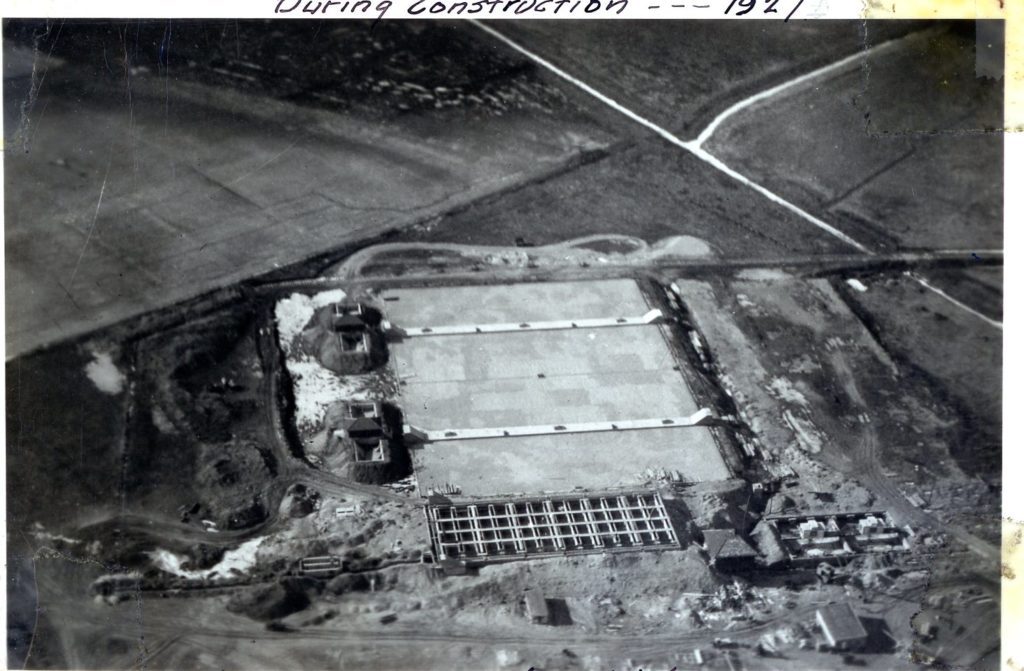“Flow of history: Creation of the Nine Springs Wastewater Treatment Plant” is the eighth article in a series outlining the history of wastewater treatment in Madison from the mid-1800s through 1914. Earlier articles are available in the History section of our blog, beginning the series with “Flow of history: Early concerns prompted community action.” A four part series on the “Creation of the Madison Metropolitan Sewerage District” covers subsequent chapters in Madison’s wastewater treatment history.
By Paul Nehm

The primary treatment portion of the Burke Wastewater Treatment Plant was placed in operation in 1914, and the trickling filters became operable in 1916, allowing the plant to produce secondary treatment quality effluent. When the Burke Plant was designed, it was projected that it would not reach its 5 millon gallons per day (MGD) capacity until 1930. However, by the summer of 1920 the plant exceeded that capacity.
But capacity was not the only challenge Madison was facing. Ever since the Burke Plant was built, there was concern among the general public that the effluent from the plant was causing the odor problems that were occurring in Lake Monona. The effluent conduit from the Burke Plant discharged into the Yahara River just upstream of where the river flowed into Lake Monona.
It’s the decaying weeds
Numerous studies and reports were conducted on the cause of the odors. All of them placed the blame for the odors on the decay of algae and aquatic weeds in the lake. The answer to why the algae and weeds were growing in the lake was not clear. At this time, nitrates and organic nitrogen were viewed as the main food for algae and other aquatic plants. Interestingly, none of the scientific studies discussed in those reports and other literature from that era ever mentioned phosphorus.
In 1920, a comprehensive study was conducted at the request of the Madison Common Council in order to determine the cause of the odors and develop remedies for it. Although the authors of the study felt the Burke Plant effluent was not the cause of the odors, they did acknowledge that the effluent did not look good. The authors proposed options to improve the quality, including adding Imhoff tanks, but none of the options were implemented.
A second plant, away from Lake Monona
In addition to the effluent quality issues, Madison needed to decide how to provide for treatment of the steadily increasing amount of wastewater being generated in the city. Two options were considered: increase the capacity of the Burke Plant or build another treatment plant and operate it along with the Burke Plant. In 1922, a committee was tasked with the job of comparing the cost of these two options. The committee compared the cost of a 5 MGD addition to the Burke Plant to the construction of a new 5 MGD plant in “the Nine Springs marsh area.”
When the committee submitted its report in January of 1923, it concluded that the construction of the second plant would save the city $269,156 during the next 10 years and $518,875 during the next 20 years. The committee recommended that the city build a 5 MGD plant on the McCauley farm in the Town of Blooming Grove. This plant should have Imhoff Tanks, sprinkling filters, and secondary sedimentation.
Citizen perception vs. report findings
It should be remembered that during this time, the Burke Plant was overloaded and producing an effluent that did not meet secondary treatment standards. The continuing concerns that many Madison residents had for the odors on Lake Monona and their belief that the odors were due to the discharge of effluent into the lake raised similar concerns in the minds of residents downstream of the proposed Nine Springs Wastewater Treatment Plant.
On September 2, 1924, the Stoughton City Council passed a resolution to have “Mr. T. Chalkley Hatton of the Milwaukee County Sewerage Commission investigate and make a report on the cause of weed growth and impurities in the waters of the Yahara River and Lake Kegonsa, and the present and proposed sewage plant of the City of Madison, Wisconsin.”
In his report, Mr. Hatton stated that he believed the effluent contained food material for the aquatic plants and thus effluent from the proposed Nine Springs Plant would contribute to weed growth in downstream water bodies. But he also concluded that the current weed growth and any impurities in the waters of Lake Kegonsa and downstream Yahara River were due to “animal and human wastes contributed by those living adjacent to these waters and from decayed algae inherent therein.”
Because he felt that the effluent would contribute to increased weed growth in the downstream lakes, he expected that it would be necessary to dredge the Yahara River between Lake Waubesa and Lake Kegonsa, as well as the portion of the river downstream of Lake Kegonsa. Under the conditions current at that time, floating weed bogs had evidently blocked flow of the Yahara River to the Stoughton dam at times. Since the City of Madison’s treatment plant would be contributing to the projected increased growth of weeds, Mr. Hatton recommended that the City share in the cost of this dredging operation.
Mr. Hatton disagreed with the City of Madison cost comparison between expansion of the Burke Plant and the creation of a new plant. He felt that the decision to build the second plant was made “to overcome the strenuous objections of its citizens to discharging any sewage effluent into Lake Monona.”
Much of the information for the article series was found in “Madison – A History of the Formative Years” by David V. Mollenhoff and in articles written by early leaders from Madison’s public works sector. The article was originally published in the Fall 2021 edition of the District’s newsletter, The Clarifier.






